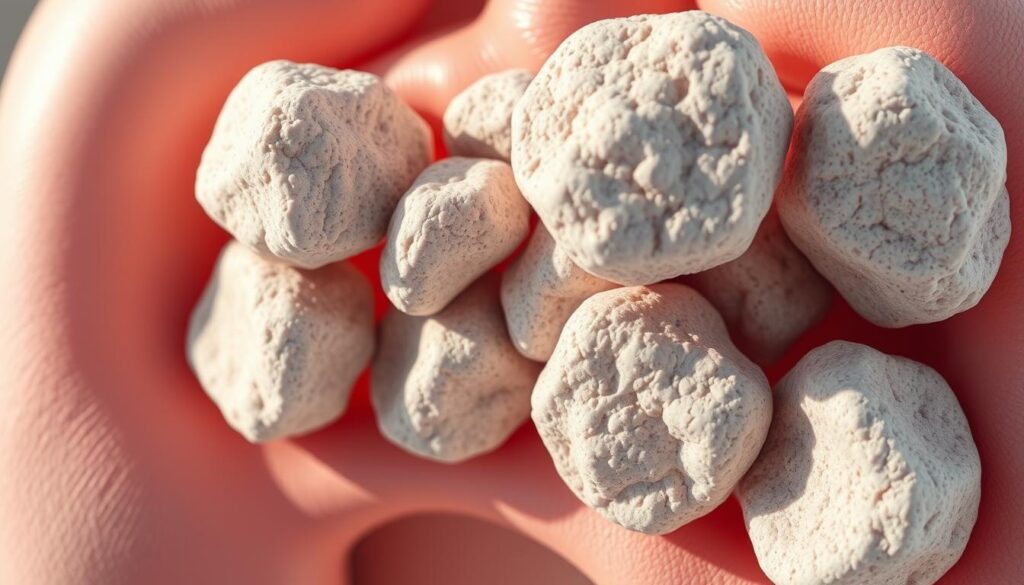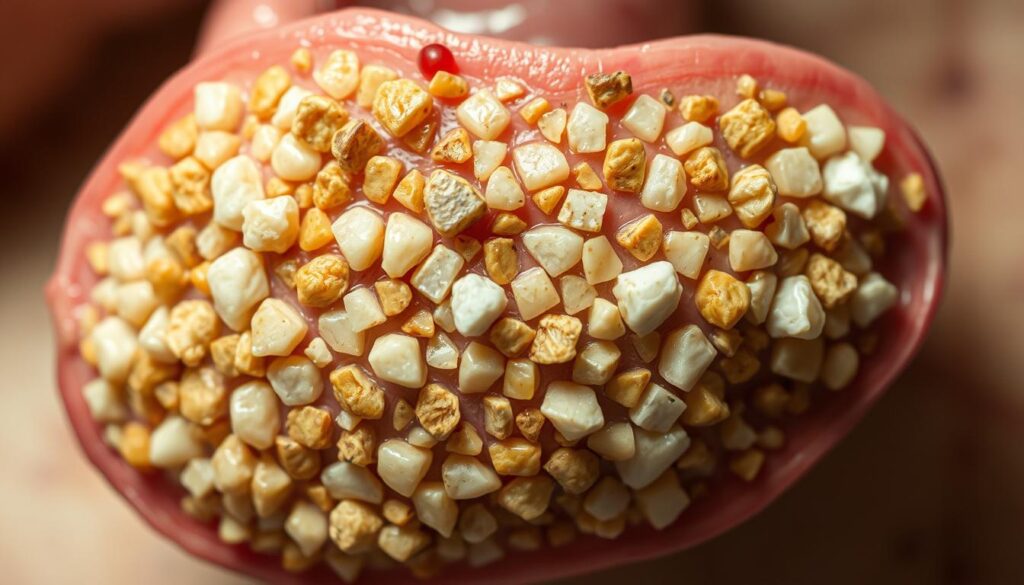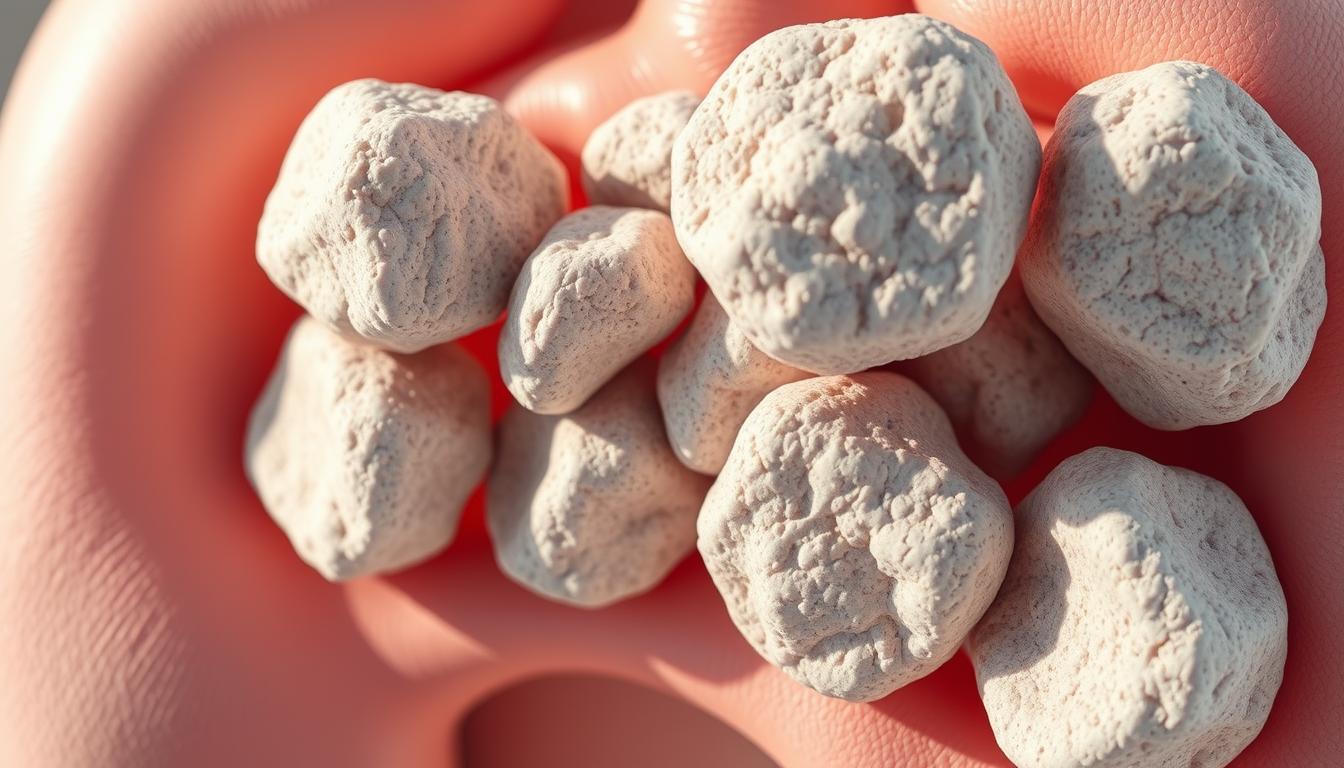Prostate Gland Stones: Symptoms, Diagnosis, and Management
A tiny calcium deposits in the prostate gland a cause for concern? For many men, especially as they age, prostate stones can become a reality. But what exactly are they, and how do they affect overall health?

We will explore how these small deposits, often harmless, can sometimes lead to significant discomfort and urinary problems. Studies have shown that between 7% and 70% of men are affected by prostate gland stones, with incidence increasing with age. Understanding this condition is crucial, as many men remain unaware of its implications.
Our comprehensive guide will walk you through the causes, symptoms, diagnosis methods, and treatment options for stones in the prostate gland. With proper knowledge and medical care, most men can effectively manage their condition and maintain a good quality of life.
Key Takeaways
- Prostate stones are small calcium deposits that form within the prostate gland.
- They are very common among men, particularly as they age.
- Prostate stones can cause urinary issues and discomfort, despite the fact that they are typically unnoticeable.
- The prevalence of prostate stones ranges between 7% and 70% among men.
- For managing the condition, it is essential to comprehend the symptoms, causes, and available treatments.
- Proper medical care can help men with prostate stones maintain a good quality of life.
Understanding Prostate Gland Stones
Prostate gland stones, also known as prostatic calculi, are mineral deposits that form within the prostate gland. These stones are typically small, ranging from half a millimeter to five millimeters in size, comparable to poppy seeds or millet seeds.
What Are Prostate Gland Stones?
Prostate stones are small calcium deposits that build up in a man’s prostatic gland, particularly from middle-age onwards. They are often made up of calcium phosphate, a substance also found in bones and teeth. Some men have one stone, while others have several.
How Common Are Prostate Stones?
Prostate stones occur primarily in middle-aged and older men, with their incidence increasing significantly after age 50. Many men with prostate stones do not exhibit symptoms, but in some cases, these stones can indicate underlying prostate conditions or contribute to urinary symptoms.
Difference Between Prostate Stones and Other Urinary Calculi
It’s essential to distinguish prostate stones from other types of urinary calculi, such as kidney stones, which occur in the kidneys, ureter, or bladder. Prostate stones develop specifically within the prostate gland, in contrast to kidney stones. For accurate diagnosis and treatment, this distinction is essential.
| Characteristics | Prostate Stones | Kidney Stones |
|---|---|---|
| Location | Form within the prostate gland | Occur in kidneys, ureter, or bladder |
| Composition | Typically calcium phosphate | Varies (calcium oxalate, uric acid, etc.) |
| Size | Half a millimeter to five millimeters | Varies, often larger than prostate stones |
As noted by a medical expert, “Understanding the differences between prostate stones and other urinary calculi is crucial for proper diagnosis and treatment.” This highlights the importance of accurate diagnosis in managing prostate gland stones effectively.
Causes and Risk Factors of Prostate Gland Stone
In order to treat and prevent prostate gland stones, it is essential to comprehend their causes and risk factors. Prostate stones are mineral deposits that form within the prostate gland, often due to specific underlying causes.
How Prostate Stones Form
Prostate stones found to be favored by normal aging processes. There are two main theories regarding their formation: deposits might form in the secretion of the prostate gland which then calcify due to inflammations, or a urine blockage in the prostatic gland might help the stones form.
Age-Related Factors
As men get older, changes in the prostate gland increase the risk of stone formation. This is why men over 50 are at a higher risk.
Medical Conditions That Increase Risk
Benign Prostatic Hyperplasia
The prostate undergoes structural and functional changes in benign prostatic hyperplasia (BPH).Stones can form more easily as a result of this.
Chronic Prostatitis
Inflammation from chronic prostatitis can cause calcification. This increases the risk of stone formation in the prostate.
Urinary Tract Infections
Prostate stones can also result from infections of the urinary tract. This is especially true for infections that keep coming back or aren’t treated well.
| Risk Factor | Description |
|---|---|
| Age | Men over 50 are at higher risk |
| BPH | Alters prostate structure and function |
| Chronic Prostatitis | Ongoing inflammation leads to calcification |
| Urinary Tract Infections | Recurrent or untreated infections contribute to stone formation |
Recognizing Symptoms of Prostate Gland Stone
Men with prostate stones may have various symptoms that affect their daily life. Some men may not show any symptoms at all. Others may face a lot of discomfort and urinary problems.
Common Urinary Symptoms
Prostate stones can cause several urinary symptoms. These symptoms can greatly impact a man’s daily activities.
Urinary Urgency and Frequency
One common symptom is urinary urgency and frequency. This can disrupt sleep, especially at night. Even if there isn’t much urine in the bladder, men may still need to urinate frequently.
Difficulty Urinating
Prostate stones can also cause difficulty urinating. This includes a weak urinary stream, straining to start urinating, and feeling like the bladder isn’t fully empty.
Pain and Discomfort
Prostate stones are characterized by significant signs of pain and discomfort.
Pelvic and Perineal Pain
Men may feel pain in the pelvic area and perineum. This pain can be ongoing and uncomfortable.
Lower Back Discomfort
Lower back discomfort is another common symptom. This pain often starts in the pelvic area.
When Symptoms Require Medical Attention
Seek medical help if symptoms get worse or if there are signs of severe complications. Severe pain, blood in urine, or a complete inability to urinate are signs that need immediate attention.
Diagnosis Methods for Prostate Stones
Diagnosing prostate stones involves several steps. Physical examinations, a review of medical history, and a variety of tests are among these. This detailed process helps doctors accurately identify prostate stones and tell them apart from other conditions.
Physical Examination
A digital rectal examination (DRE) is key in assessing the prostate gland. Healthcare providers may feel larger prostate stones during a DRE. This exam gives important information about the prostate’s condition.
Imaging Techniques
Imaging techniques are key in diagnosing prostate stones.
Transrectal Ultrasound
The primary method for detecting prostate stones is transrectal ultrasound (TRUS). It uses a probe in the rectum to show the prostate gland and any stones.
CT Scans and X-rays
CT scans and X-rays help too, especially for detailed views. They show the size, number, and where the stones are.

Laboratory Tests
Laboratory tests are key for spotting infections or inflammation with prostate stones.
Urinalysis and Culture
Urinalysis and urine culture check for urinary tract infections linked to prostate stones. These tests guide treatment.
PSA Testing
PSA (prostate-specific antigen) testing is also important. It helps tell if the problem is prostate stones or prostate cancer.
Treatment Options for Prostate Gland Stone
Managing prostate stones involves different treatment options. Symptoms, stone size, and other conditions influence choices.
Conservative Management Approaches
Often, no treatment is needed for prostate stones. A watchful waiting approach is used. To pass small stones, Drinking more water is essential.
Medication Therapies
When treatment is needed, medicines are key. Antibiotics treat infections. Anti-inflammatory drugs help with pain.
Antibiotics for Infection
Antibiotics are vital for infections with prostate stones.
Pain Management
Controlling pain is important for men with prostate stones.
Surgical Interventions
For severe cases or when other treatments fail, surgery is needed. Through the urethra, stones and excess tissue are removed during Transurethral Resection of the Prostate (TURP).
Transurethral Resection of the Prostate (TURP)
Transurethral resection of the prostate works well for big stones and enlarged prostate.
Minimally Invasive Procedures
Laser lithotripsy is a treatment that breaks stones into smaller pieces. These can then pass naturally.
It’s crucial to have a treatment plan tailored to your needs. Talk to a doctor who specializes in prostate care, such as a urologist.
Prevention Strategies and Lifestyle Modifications
While some prostate stones can’t be prevented, lifestyle changes can help. These changes can reduce risk and manage stones. By making these changes, you can improve your prostate health.
Dietary Recommendations
Prostate stones can be avoided by eating a well-balanced diet. Eating less of foods high in oxalates and purines is a good start. Also, eating more fruits and veggies and eating animal proteins in moderation helps. These steps not only help your prostate but also your overall health.
Hydration Importance
Drinking enough water is crucial to stop stones from forming. Drinking water keeps your urine diluted and helps flush out your system. This reduces the chance of stones forming.
Physical Activity Benefits
Staying active is good for your prostate. It improves blood flow, lowers inflammation, and keeps your weight healthy. Walking or yoga that focuses on the pelvic area is especially good.
Regular Prostate Health Check-ups
Getting regular check-ups is important, especially for men over 50 or those at risk. Finding stones or other issues early can greatly improve treatment results.
Conclusion: Living with Prostate Stones
Prostate stones can be tough, but they don’t have to ruin your life. Knowing what causes them, recognizing symptoms, and looking into treatments can help manage them well.
Managing prostate stones well means both medical treatment and changing your lifestyle. Eating right, drinking plenty of water, and staying active are key. These steps can really help lessen symptoms.
For men with prostate stones, getting support is key. Online forums, support groups, and prostate health organizations offer great advice and emotional support.
It’s also important to deal with the emotional side of having prostate stones. While most are not cancerous, regular check-ups and talking to your doctor are essential for your health.
By taking care of your prostate health, men can live full lives even with stones. We encourage men to focus on their prostate health and seek help when they need it.
FAQ
What are the symptoms of prostate stones?
Symptoms include painful urination, trouble starting or stopping, needing to urinate often, and pain in the lower back, perineum, or genitals.
How are prostate calculi diagnosed?
We diagnose prostate stones through physical exams, imaging like ultrasound or X-ray, and lab tests on urine and prostatic fluid.
Can benign prostatic hyperplasia increase the risk of developing prostate stones?
Yes, men with benign prostatic hyperplasia are more likely to get prostate stones. This is because of urinary stasis and other factors.
What are the treatment options for prostate stones?
Treatment options include conservative management, medication like antibiotics, and surgery like transurethral resection of the prostate.
How can we prevent urinary tract infections associated with prostate stones?
To lower UTI risk, practice good hygiene, drink plenty of water, and see a doctor quickly if symptoms show up.
Are there any lifestyle modifications that can help manage prostate stones?
Yes, making dietary changes, drinking more water, staying active, and getting regular check-ups can help manage prostate stones and prevent problems.
Is it possible for prostate stones to form as a result of chronic prostatitis?
Yes, chronic prostatitis can raise the risk of prostate stones. This is due to ongoing inflammation and other factors.



Post Comment